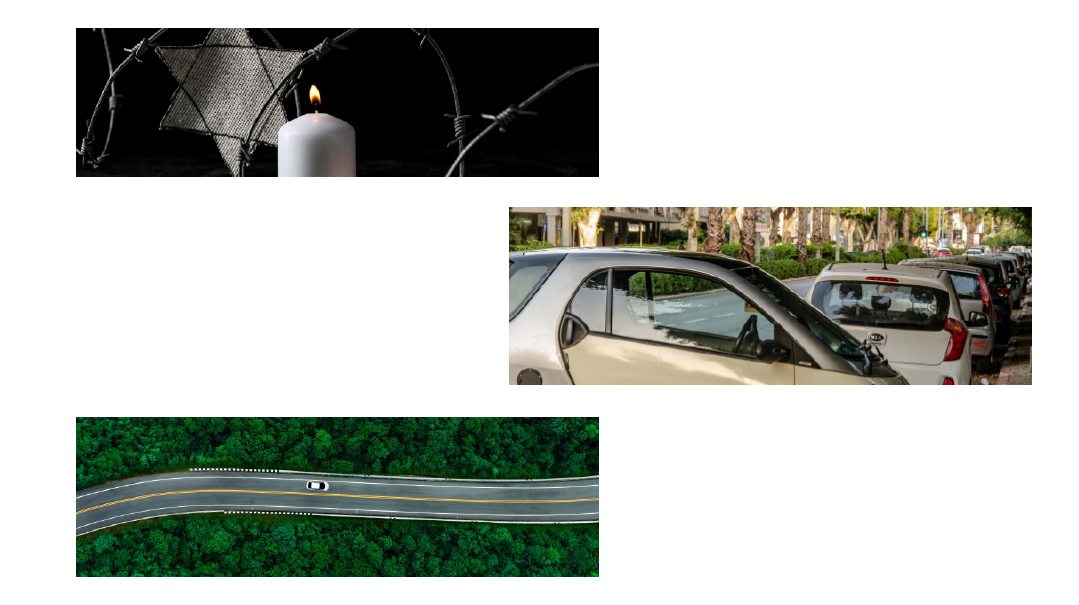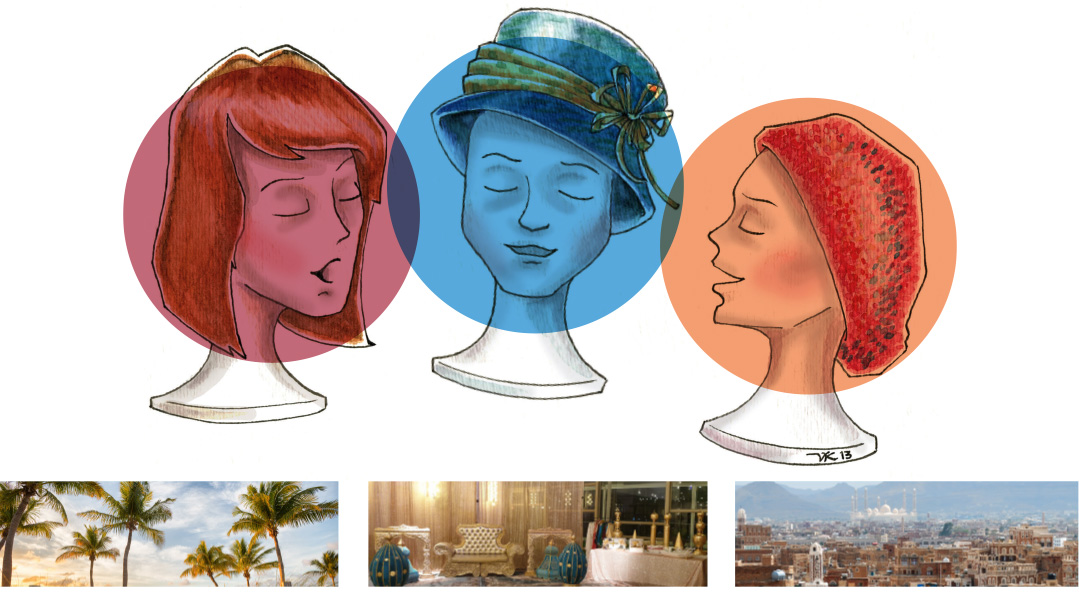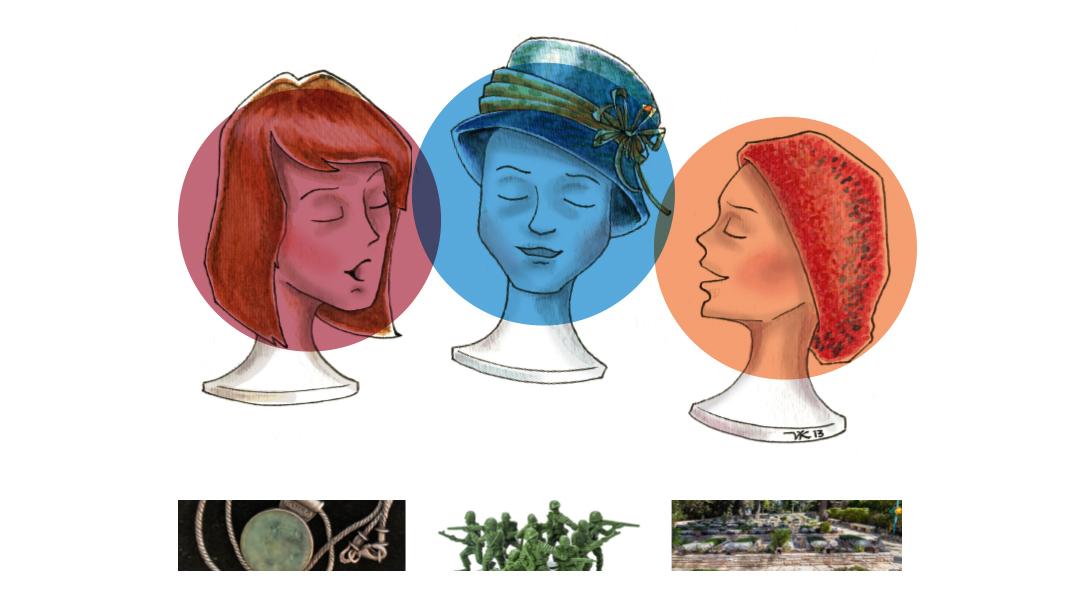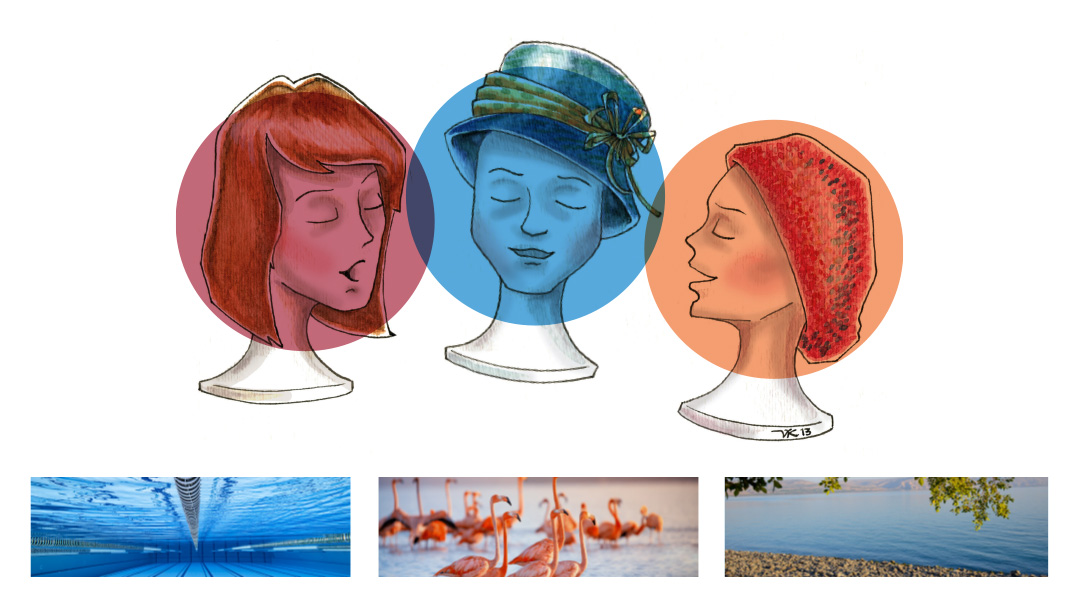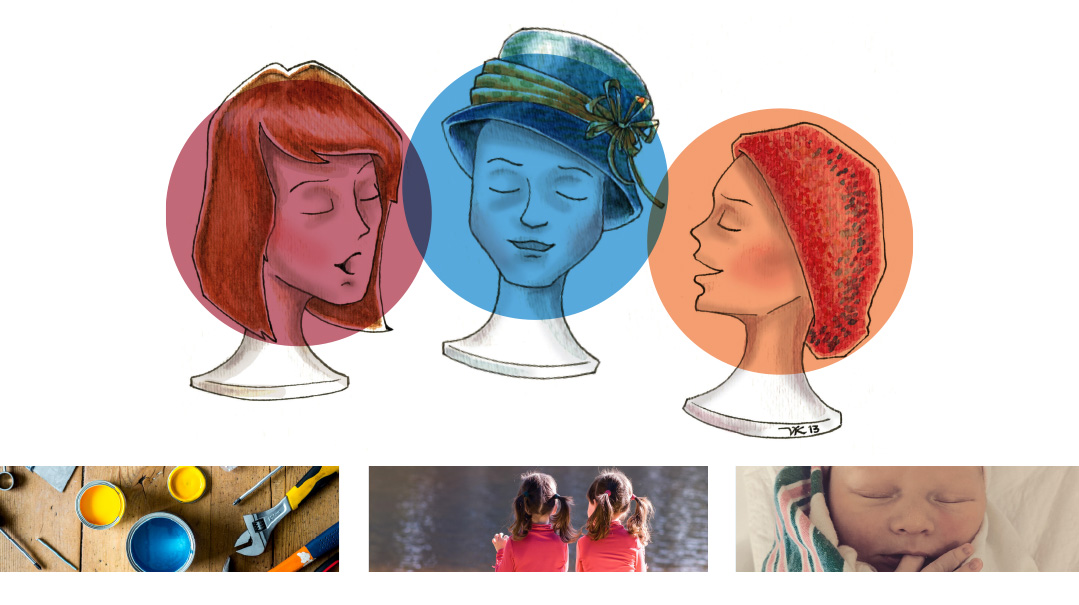Frame of Preference
| October 30, 2019Join the Sisters as we explore changing perspectives through our own ambiguous images. Which picture do you see?
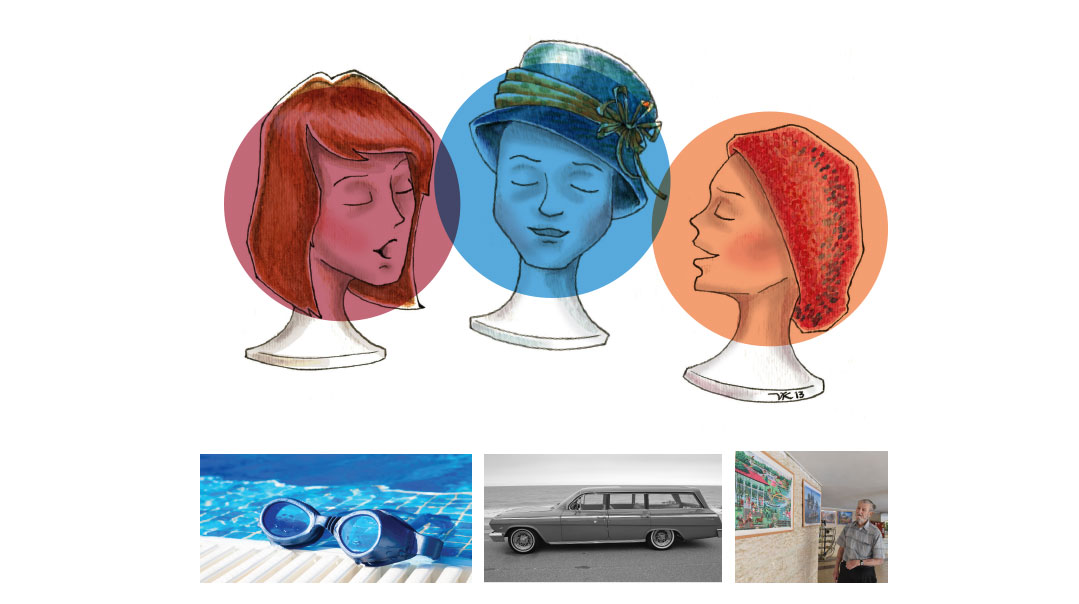
Agoblet or two profiles? A duck or a rabbit? A young woman wearing a chic feathered hat, or an old crone with a pointy chin?
We’ve all seen these strange pictures, known as “ambiguous images.” You stare at the picture and see one thing — until suddenly, something else entirely fills your field of vision.
Two pictures, both true, but what we see depends on how we look at it. And perhaps when, where, and how long we look at it. Our perspectives can change with each step we take, with each person we meet, with each adventure we experience. Perspectives change every day we grow older and, hopefully, wiser.
A tough young man with a ponytail — or a spiritual messenger? A beat-up old car — or a trusted friend? A neighborhood where every house and every person looks the same — or a place where unique pieces come together to make a lovely whole?
Join the Sisters as we explore changing perspectives through our own ambiguous images. Which picture do you see?
Emmy Leah focuses on…
New Goggles
Off to a morning at the beach, and I was well prepared. Sunscreen against burns. Vinegar for stings from Mediterranean jellyfish known as medusas. Floppy hat, beach chair, sunglasses — everything I needed for a safe and enjoyable swim.
But once I got there, I found one thing I hadn’t counted on. Something I never encounter during my twice-a-week pool swim.
Waves.
Not the calm and benign waves that gently push me toward shore during my once-a-year, early morning Kinneret swim-a-thon. Rather, roaring, crashing, booming, brutal waves.
Waves that turned me upside down — and eventually helped turn my ideas about people upside down too.
It was my own fault. Marcia, more experienced at swimming in turbulent ocean waters, advised swimming out further, where the water was calmer. But I enjoyed jumping over waves as they crashed near the shore. Besides, wasn’t it safer to stay closer to land?
The answer that day was a decided NO. Because while I swam horizontally, parallel to the coastline, I was suddenly engulfed, completely overcome by a huge wave crashing toward shore.
It only took a few seconds, but they were the longest seconds I’d ever experienced. The wave turned me over completely. I couldn’t get my footing, wasn’t sure what direction was up toward air, sky, life, and what direction was down, down toward mud, rocks, and…
Breathless, totally out of control, I felt myself being pulled toward the frightening depths. Or was I being pushed toward shore?
Moments later, I found myself on my knees, blessed blue sky above me. But my ordeal wasn’t over yet. I’d landed close to shore, where wave upon wave broke over me. Between waves, the water was shallow. But I was half blinded, overwhelmed with the taste of salt, completely shocked. Baruch Hashem two young girls playing in the water saw my distress, ran over, and helped me to my feet.
Marcia saw me stumble shakily out of the water and came running.
“Are you okay? I lost sight of you. What happened? And what happened to your goggles?”
My goggles! No wonder I could hardly see — somewhere in my wild encounter with the wave, as I struggled, suspended upside down in the water, my prescription goggles had been pulled off my face by the force of the sea. I staggered to the beach chair, grabbed my glasses, and began seeing once again.
Had I really been in danger? Or had I just been through an incredibly uncomfortable minute? Was there some greater meaning to this short but intense experience?
Truthfully — I didn’t know. I did know that minutes afterward I was talking and laughing again with my friends, watching girls throw beach balls, and seeing swimmers jump over the waves safely.
And I also knew that… I needed a new pair of prescription goggles.
Later that day... I step into a sports store in Beit Shemesh. Not exactly my natural habitat. Young people in shorts and T-shirts buying camping equipment, discussing soccer balls, trying on expensive sports shoes.
A young man with a ponytail, sporting several studs in his ear, comes over. He shows me the rack of prescription goggles. I find a pair that seems right and go to pay. I mention that I lost my old ones when a wild wave overturned me that morning.
The young man seems concerned. More than that, he probes, wants to know what I will do now. This apparently nonreligious salesman asks: Will I give money to tzedakah? Will I say a special brachah? What hishtadlut will I do to make sure this never happens again?
That morning, a turbulent sea had turned me upside down. Now, in the sports store, I feel my world turning around again. A young man without a kippah understands better than I that such an experience has meaning, that I need to acknowledge Hashem’s kindness in saving me from danger.
I thank the young man, we give each other brachos for safety and health, and I walk out with my new prescription goggles. They really will help me see better.
Even when I’m not swimming.
Marcia views life…
Through an Automotive Perspective
Our first car. A rusty blue Opel Kadett. It must have been at least 10 years old, but looked like it had spent 20 years bumping over rocks, sloshing through mud, and splashing through puddles. We got it as a gift from a fellow newlywed couple, less impoverished than we were.
If you’d lift the floor mat, you’d see pavement. Hence our nickname: the Flintstone Mobile. Another fun feature: broken windshield wipers. Once, driving down Ocean Parkway during a mabul, we stuck our hands out of our respective windows, and swished the blades manually. We got soaked — and enjoyed a good laugh.
Another perk was the “push start” — a unique method for turning on the engine. I’d put the car in neutral, my husband would physically push from behind, and I’d turn the key and floor the accelerator while “popping the clutch.” (Note for millennials: A clutch is the third pedal in cars that have stick shifts — a rarity even back then). A problem? No — a team-building newlywed activity!
After a while, manual push starts weren’t enough. We needed something stronger to do the pushing — another car. This technique could be rough on bumpers, but our young car-owner friends gladly helped. Once, though, when we stalled on a narrow service road, the driver behind us wasn’t happy. We explained that the only way to get past us would be to push start us with his Cadillac. We were puzzled: Why was he so upset?
What adventures we had during those carefree days!
As our family started growing, we went through several other used cars. Another stick-shift Opel before the birth of our first child — fire engine red with a black racing stripe. A more sedate white Plymouth Valiant before our second child was born.
And then came the Chevy Impala wagon.
With our move to suburbia and the world of school car pools, my main used-car requirement was MKC: maximum kid capacity. The Impala’s “backie-back” was the source of many fights about who’d get to ride backward. Our beloved Old Beast kept chugging away, rusting on the outside but solid on the inside, faithfully ferrying kids for many years.
Until one day when everything changed.
I had to attend a client meeting in downtown D.C. Nancy, my government project officer, commuted from Maryland by Metro, but — knowing I’d have to head straight to car pool afterward — I drove Old Beast. After the meeting, I asked Nancy if she’d like a ride to nearby Union Station.
“Sure,” she replied.
Walking through the parking lot, we approached the Impala sitting in all its rusty splendor. Nancy peered into the stained, candy-wrapper-filled vinyl interior.
“Never mind, I think I’ll walk.”
“Sorry Nancy. If I’d known you were coming, I’d have brought my Porsche.”
After that, I never looked at Old Beast in quite the same way. It still worked fine, but all I could see was rust… and remember my mortification. So we donated it to charity, giving it a tearful family funeral in the Yeshiva of Greater Washington parking lot.
I’d had it with ugly old cars. Time for something pretty, something brand new.
At the dealership, it was love at first sight: a Ford Taurus station wagon. What drew me to this particular car? Engine size? Fuel mileage? Safety features? No. All I could see was its color: the most attractive, unusual shade of teal I’d ever seen.
Five years and hundreds of car pools later, the transmission died — three times in six months. And so did my midlife car-buying crisis. I rediscovered that appearance has nothing to do with quality.
I stopped looking at cars — and life — through Nancy’s eyes. Time to go back to used-but-trusty cars. My next two kid-haulers were boring used minivans that did their job just fine, dents and all.
These days, with just an occasional grandkid to haul, I’ve downsized to a blah-but-functional Camry. I bought it through a trusted mechanic who buys cars at auctions. When he asked what color I wanted, I told him “anything but black.” (Of course, it ended up being black. But that’s okay.)
When he asked what features to look for, my reply was something I’d never thought would come out of my mouth: “Heated power seats.”
I guess achy backs and stiff knees can change one’s perspective, too.
Miriam discovers…
The Puzzles of My Neighborhood
There’s a new trend in New York — bus tours to chassidic enclaves like Williamsburg and Crown Heights. What fun: a chance for the Jessicas and Ashleys, the Christophers and Tylers, to take “shtreimel selfies” to post on their Insta and Twitter accounts.
I’m pondering this cultural tourism (voyeurism?) and imagining a bus tour to my own little Har Nof enclave.
“On your right are tall white houses built of Jerusalem stone. On your left: the same.”
My imaginary tourists eagerly scan the streets for natives. They’ll see women in snoods, pre-ties, or long, luxurious locks (“Hey, Brittany, can you believe that’s a wig?”). They’ll pass by a bus stop at 8:45 a.m. and see dozens of men in white shirts, black jackets, and hats, waiting for the Mirrer bus.
Tyler, on his successful Twitter account (5K followers! Twitter heaven!) will post a pix and tweet:
“Men in black. They all look alike.”
The bus will drive up Shaulson, take a right on Chai Taib, swing around onto Brand. And soon they’ll get bored. Tyler sums it up: “Not much to see here. Everyone and everything looks the same.”
They drive out of the neighborhood, seeking more interesting spiritual adventures. Tyler has no idea that he's wrong.
So wrong.
Let’s leave the tour bus and take a walk instead. We’ll see the Mediterranean sunshine bouncing off one white stone building after another. Suddenly a flash of vivid color will catch our eye. We’ll turn into the lobby of still another white building, and enter… a museum?
Astonished, we gaze at walls covered with more than 50 works of art. We see a 1930s gas station offering a “Wash and Polish, $1.50.” Here is an antebellum Southern mansion; there, a European villa with stunning ornamental gardens. Enchanted, we wander from picture to picture, looking at railroad trestles and collections of gumdrops, buttons, and cereal boxes. The eyes of snapping turtles follow us as we walk down the stairs. We reach the building’s storage rooms. Usually a dim and dreary area, here we see a friendly general store circa 1890, and two little boys peering into a knothole in a wooden fence surrounding a baseball field.
As we walk closer to each picture we see something even more unexpected. These aren't paintings. They are each carefully crafted, lovingly built jigsaw puzzles.
Who are the creators of this puzzle wonderland?
Let’s go meet the Markowitzes.
Ronald and Miriam Markowitz are Har Nof pioneers who settled here when the neighborhood was in its infancy. They’re the kind of couple who quietly light up any room they're in, with smiling lips and sparkling eyes and the right words for all occasions; DIY people who helped build their shul and their community.
As the years passed, even these active people found themselves physically slowing down. Walking became more difficult, and they were spending more and more time in their apartment. “We wanted to keep our minds busy and active, and we didn’t want to just hang around the house,” Miriam explains to me on a recent visit to the Markowitz home, “so we began to do puzzles.”
Want to learn how you can take 1,000 or even 2,000 little pieces and turn them into one lovely picture? Ronald shows me the “puzzle trays” he constructed himself. He’s working on a 1,000-piece puzzle today, carefully sorting every piece by shape and placing it on one of the four trays.
Here’s something else I learn, which astonishes me even more than the art gallery in the lobby. Ronald Markowitz is color blind. He can make out differences between, say, red and blue, but can’t see shading at all. Ask any dissectologist (the official word for people who enjoy jigsaw puzzles; thank you, Google) and they’ll tell you that sorting the pieces begins by color. For Ronald, who can only sort by shape, putting together a puzzle is like running a marathon with a sprained ankle….
And he runs it very well.
Ronald uses shapes, Miriam uses colors, and between them they can finish a puzzle in a week or two. Then they paint the picture with glue, mount it, and build it a custom-made frame. “We put one up in the lobby. Everyone liked it, so we started to put up more.”
Three years and over 50 puzzles later, the lobby has become a quiet neighborhood icon. It draws in the casual passerby, who then brings friends and relatives to share the wonder. Shidduch dates come to stroll through it, and a preschool brings its three-year-olds once a week. And of course, residents of the building pass the puzzles on the way back from an overcrowded supermarket, a brawl with a bureaucrat, or just a tough day at work, and find themselves smiling.
When I showed the puzzle lobby to my sister Marcia, she said something interesting. “If you’re standing a few steps away, you see the picture. Come closer and your perspective completely changes; you see all the pieces.”
That observation led me to thinking about my fictional friends, the Jessicas and Tylers who’d see one homogeneous, white-building-ed, black-suited neighborhood. On that imaginary bus, they never had the chance to come close, and see the many pieces that make up my beautiful Har Nof: the searching baal teshuvah, the idealistic kollel family, the courageous ger tzedek, the struggling teenager, the tired mom, the giggling sem girls, the politicians and the techies and the playing children and the wise elders… and… and… and…
Each person a vital piece. All those pieces coming together to form one glorious whole.
What’s true of Har Nof is true, also, of our families. Our neighborhoods. Our People. Sometimes we need to stand back to see the whole picture. Other times we should come closer and appreciate every single person.
Every single piece of our very beautiful puzzle.
(Originally featured in Family First, Issue 665)
Oops! We could not locate your form.


